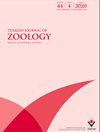Diversity and prevalence of ornithophilic louse flies (Diptera: Hippoboscidae: Ornithomyinae) in Serbia
IF 1.3
4区 生物学
Q2 ZOOLOGY
引用次数: 2
Abstract
: Ectoparasites are diverse organisms that exploit animal hosts using various strategies. One such group represents the louse flies (Hippoboscidae) from the subfamily Ornithomyinae, which are permanent, highly specialised, hematophagous ectoparasites of poultry and wild birds found worldwide. The main objective of this research is to examine the mean abundance, prevalence, and diversity of ornithophilic louse flies in Serbia. They have been detected through visual inspection or fumigation of caught birds. In total, 79 louse flies belonging to four genera and six species were collected from 62 individuals within 26 host species. A single louse fly infested the bulk of captured birds, while hippoboscid females were statistically dominant within the overall sample. Most detected louse flies belonged to the genus Ornithomya , with Ornithomya avicularia and Ornithomya fringillina being the most abundant at the species level. The prevalence was relatively low, along with the mean intensity and abundance. This study contributes to a better understanding of louse flies and their parasite-host associations in Serbia. It also fills a gap in the knowledge of their diversity and distribution in South-eastern Europe.塞尔维亚嗜鸟虱的多样性和流行率
:外寄生虫是利用各种策略利用动物宿主的多种生物。其中一个群体代表了鸟粪亚科的虱子蝇(Hippoboscidae),它们是世界各地发现的家禽和野生鸟类的永久性、高度专业化、吸血的体外寄生虫。这项研究的主要目的是调查塞尔维亚嗜鸟虱子蝇的平均丰度、流行率和多样性。它们是通过目视检查或对捕获的鸟类进行熏蒸检测到的。共从26个寄主物种中的62个个体中采集到隶属于4属6种的79只虱子蝇。捕获的大部分鸟类中都有一只虱子蝇,而在整个样本中,嗜河马的雌性在统计上占主导地位。大多数被检测到的虱子蝇属于鸟粪蝇属,其中鸟类鸟粪蝇和边缘鸟粪蝇在物种层面上数量最多。患病率相对较低,平均强度和丰度也相对较低。这项研究有助于更好地了解塞尔维亚的虱子蝇及其寄生宿主的关系。它还填补了人们对其在东南欧的多样性和分布的了解空白。
本文章由计算机程序翻译,如有差异,请以英文原文为准。
求助全文
约1分钟内获得全文
求助全文
来源期刊

Turkish Journal of Zoology
ZOOLOGY-
CiteScore
2.30
自引率
10.00%
发文量
24
审稿时长
6-12 weeks
期刊介绍:
The Turkish Journal of Zoology is published electronically 6 times a year by the Scientific and Technological Research Council of Turkey (TÜBİTAK).
-Accepts English-language manuscripts in various fields of zoology including systematics, developmental biology, behaviour biology, animal models, molecular biology and molecular phylogeny, genomics, physiology (cell communication and signaling systems), biochemistry and immunohistochemistry, applied parasitology and pathology, nanobiotechnology, ecology, evolution, and paleontology of animal taxa.
-Contribution is open to researchers of all nationalities.
-Short communications are also welcome, such as reports of a preliminary nature or those including new records from specific localities or regions, and the editor reserves the right to decide that a paper be treated as a short communication.
-The papers that deal with purely checklists, new host and non-regional new locality records will not be consider for publication.
-Letters to the editor reflect the opinions of other researchers on the articles published in the journal. The editor may also invite review articles concerning recent developments in particular areas of interest.
 求助内容:
求助内容: 应助结果提醒方式:
应助结果提醒方式:


